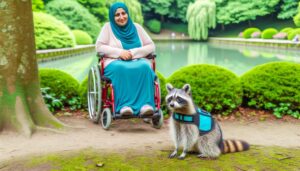How Do Raccoons Live in Groups?
Raccoons display a complex social structure that allows for both solitary and group living depending on environmental conditions. Males often form temporary coalitions during the breeding season, while females maintain home ranges with their offspring.
Family units, typically consisting of a mother and her young, stay together for several months, fostering essential social and survival skills. Group living enhances foraging efficiency and resource acquisition, particularly in urban settings.
However, raccoons generally prefer solitary lifestyles in wild habitats to reduce competition for resources. Seasonal behaviors also influence their social interactions, with more details unraveling further nuances.
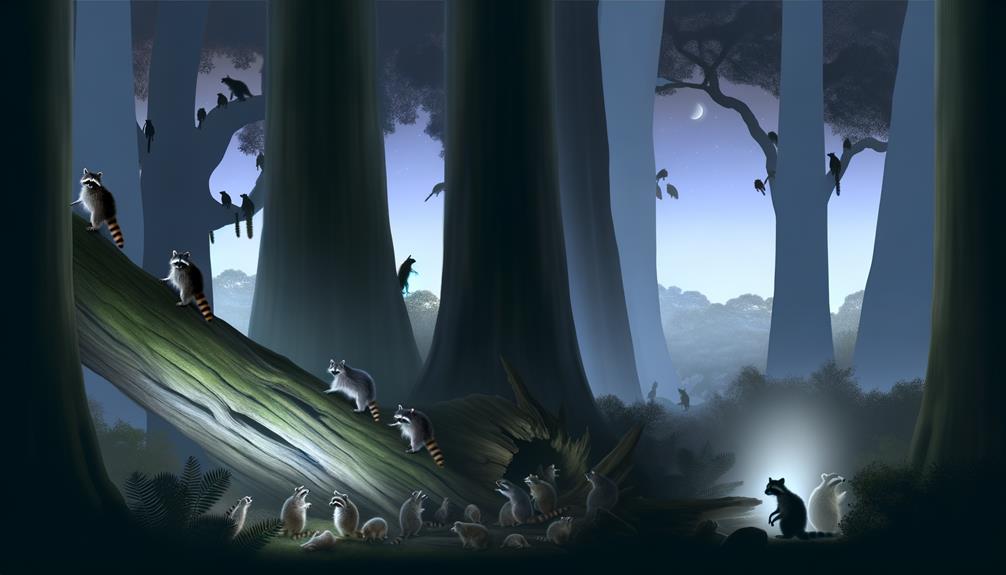
Key Takeaways
- Raccoons exhibit a flexible social structure, adapting group living based on environmental conditions.
- Females live with their offspring, forming temporary family units for several months.
- Males form coalitions during the breeding season to enhance reproductive success.
- Urban raccoons are more likely to form larger, cohesive groups due to resource availability.
- Group living in raccoons can improve foraging efficiency and offer cooperative care for young.
Raccoon Social Structure
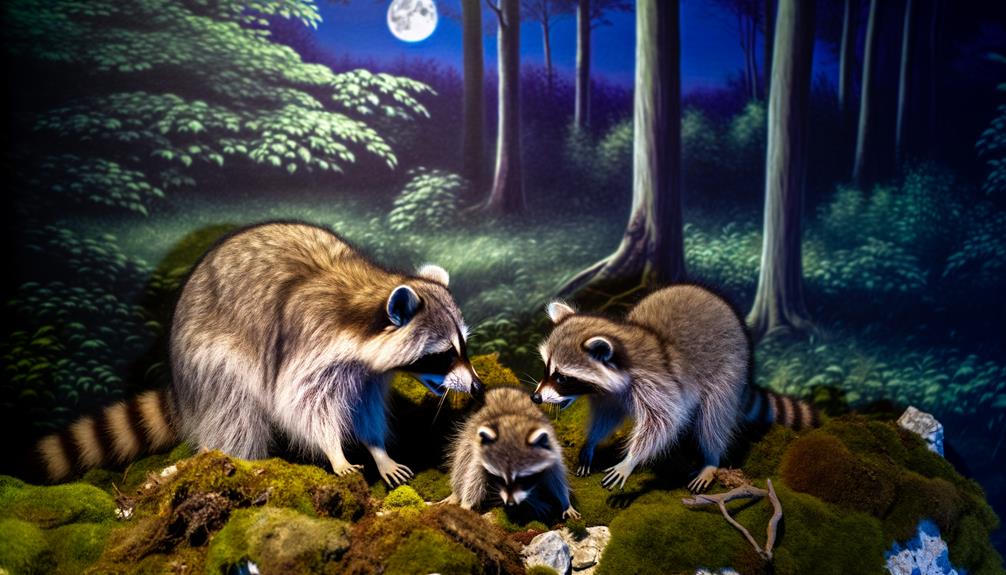
Raccoon social structure is characterized by a complex system of loosely organized groups, primarily influenced by seasonal changes and resource availability.
During the breeding season, males often form coalitions, which can enhance their chances of reproductive success.
Females, on the other hand, usually maintain home ranges that they may share with their offspring until the juveniles are independent. These home ranges can overlap, leading to temporary associations among females.
Additionally, raccoons exhibit a high degree of flexibility in their social interactions, adapting their behaviors based on environmental conditions and food sources.
Such plasticity allows them to exploit a variety of habitats, from urban areas to dense forests, ensuring their survival and reproductive success across diverse ecosystems.
Solitary Vs. Group Living
In examining the dynamics of raccoon behavior, a notable dichotomy emerges between solitary living and group living, each exhibiting distinct adaptive advantages.
Solitary raccoons benefit from reduced competition for resources and can more efficiently exploit their habitats. This behavior is typically observed in males, who establish and defend exclusive territories.
Conversely, group living, often seen among females, facilitates cooperative care of offspring and increased survival rates through shared vigilance against predators. Group living also enhances foraging efficiency and resource acquisition.
Both strategies reflect an intricate balance between maximizing individual fitness and leveraging social cooperation. Understanding these diverse behaviors provides insights into the ecological niches raccoons occupy and their adaptive responses to environmental pressures.
Family Units
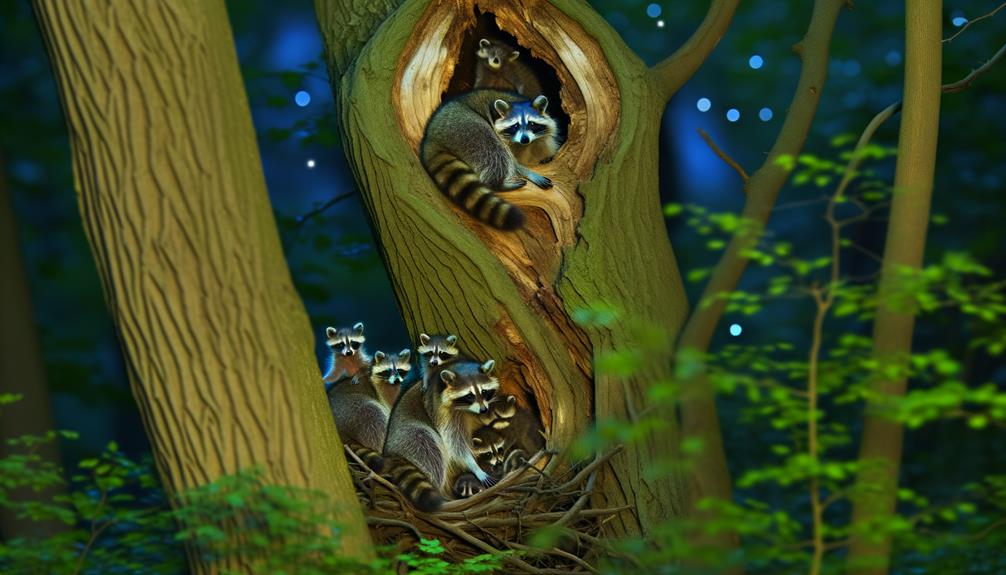
Within raccoon populations, family units are an important social structure that greatly influences reproductive success and offspring survival. Typically, these units consist of a mother and her young. The mother raccoon, or dam, exhibits strong maternal behaviors, including nursing, grooming, and teaching foraging skills to her offspring.
These family units can remain together for several months, particularly during the early life stages of the kits. Juveniles benefit from the protective and nurturing environment provided by their mother, which greatly enhances their chances of reaching maturity. Observations indicate that such familial bonds are essential for the development of social and survival skills in young raccoons, ultimately contributing to their long-term fitness and adaptability in diverse habitats.
Seasonal Behavior
As family units disband, raccoons exhibit distinct seasonal behaviors that are influenced by changes in temperature, food availability, and reproductive cycles. During autumn, raccoons increase their foraging activities to accumulate fat reserves necessary for the winter months. This period often sees heightened solitary behavior as individuals focus on maximizing food intake.
In winter, raccoons enter a state of torpor, reducing activity levels to conserve energy. They seek sheltered dens to protect against cold temperatures.
Conversely, spring and summer witness increased activity and social interactions as raccoons exploit abundant food resources and prepare for the breeding season. These seasonal adaptations are critical for their survival and demonstrate the species' flexibility in responding to environmental fluctuations.
Mating Habits

Raccoons display a polygynous mating system, where dominant males often mate with multiple females during the breeding season. This period usually occurs from January to March in temperate regions. Males engage in competitive behavior to establish dominance, which includes vocalizations, displays of strength, and occasionally physical confrontations. Females show signs of estrus and may mate with several males, although dominant males secure the majority of copulations.
Copulation itself is brief, lasting only a few minutes. Post-mating, males do not participate in rearing offspring and typically resume solitary behaviors. This reproductive strategy guarantees genetic diversity and maximizes reproductive success within the population. Understanding these mating habits provides insight into the social dynamics and population structure of raccoons.
Mother and Cubs
The relationship between a mother raccoon and her cubs is characterized by significant maternal bonding time, essential for the offspring's development.
During this period, the mother imparts vital early life lessons, including foraging skills and predator avoidance strategies.
These interactions not only guarantee the cubs' immediate survival but also play a significant role in their long-term adaptability within their social groups.
Maternal Bonding Time
During the initial weeks after birth, mother raccoons invest a considerable amount of time nurturing and protecting their cubs, establishing an important foundation for their development and survival. This period is characterized by intense maternal bonding, where the mother ensures the cubs' needs for warmth, nutrition, and safety are carefully met. The maternal care includes regular grooming, which helps to maintain hygiene and strengthen social bonds. Additionally, the mother raccoon teaches cubs initial survival skills and provides constant vigilance against predators.
Here is a summarization of key aspects:
| Aspect | Description |
|---|---|
| Nutrition | Regular feeding of milk |
| Warmth | Constant physical closeness |
| Protection | Vigilance against predators |
| Grooming | Maintaining hygiene and social bonds |
| Initial Training | Introduction to basic survival skills |
This important bonding time has a significant impact on the cubs' future adaptability and independence.
Early Life Lessons
In the early stages of life, cubs acquire essential survival skills through close observation and interaction with their mother. During this period, the mother raccoon plays a pivotal role, teaching her young vital behaviors such as foraging techniques, predator avoidance, and den site selection.
Observational studies indicate that cubs learn to identify edible items and proper food handling through mimicry. Additionally, the mother demonstrates climbing and swimming skills essential for escaping threats and maneuvering their environment.
These early life lessons are critical as they directly impact the cubs' ability to survive independently in the wild. The maternal investment during this formative period highlights the importance of the mother's role in the cubs' development and future success.
Territoriality

Territoriality in raccoons is characterized by the defense of their home range, where individuals or groups actively mark territory boundaries using scent glands. These markings serve as a deterrent to intruders, thereby reducing the likelihood of conflict.
When disputes arise, raccoons engage in specific behaviors to resolve conflicts, often through displays of aggression or dominance rather than physical confrontation.
Defending Their Home Range
Raccoons exhibit strong territorial behavior, meticulously marking and defending their home range to guarantee access to essential resources. Their home ranges vary in size, influenced by factors such as food availability, habitat quality, and population density. They actively patrol and defend these territories from intruders using vocalizations, physical confrontations, and strategic positioning.
| Factor | Impact on Home Range Size |
|---|---|
| Food Availability | Larger ranges in scarce areas |
| Habitat Quality | Smaller ranges in high-quality areas |
| Population Density | Smaller ranges in high-density areas |
Observations indicate that male raccoons tend to have larger territories compared to females, which may overlap with those of other males. Females, particularly those with offspring, show heightened aggression to protect limited resources. This behavior underscores the importance of territoriality in raccoon survival and reproductive success.
Marking Territory Boundaries
To define their home range, raccoons utilize a combination of scent marking, vocalizations, and physical cues to establish and maintain territorial boundaries. They employ scent glands located near their anus, mouth, and paws to mark objects and paths within their territory. This olfactory signaling serves as a deterrent to intruders and a guide for resident raccoons.
Vocalizations, including growls, screams, and purrs, further communicate the presence of an established territory. Additionally, raccoons use physical cues such as scratching trees and creating latrine sites at the edges of their range. These multiple methods collectively ensure that raccoons effectively claim and defend their specific home areas, reducing the likelihood of unintentional encroachment by other raccoons.
Conflict and Resolution
In instances where territorial boundaries are contested, conflicts among raccoons often arise, necessitating mechanisms of resolution to maintain social order and minimize physical confrontations. Raccoons exhibit a range of behaviors to assert dominance and establish territory without resorting to violence. Vocalizations, scent marking, and posturing are primary methods to communicate territorial claims. When these signals are insufficient, minor skirmishes can occur, typically involving brief physical engagements rather than prolonged fights. Social hierarchies within raccoon populations help to mediate these conflicts, with dominant individuals usually prevailing in territorial disputes. This structured approach to conflict resolution plays a critical role in reducing injury and maintaining communal stability.
| Behavior | Purpose | Outcome |
|---|---|---|
| Vocalizations | Assert dominance | Deters potential rivals |
| Scent marking | Establish territory | Communicates boundaries |
| Physical skirmishes | Resolve disputes | Reinforces hierarchies |
Food Gathering
The complex social structures of raccoon groups play a significant role in their food gathering strategies. Raccoons exhibit a high degree of adaptability and resourcefulness in their search for sustenance.
They often forage in groups, which increases their efficiency and success rate. Group foraging allows raccoons to exploit a variety of food sources, such as fruits, nuts, small animals, and human refuse. This collaborative effort also provides protection from potential predators, as multiple raccoons can keep watch while others forage.
Additionally, social learning plays an essential part; younger raccoons learn effective foraging techniques by observing more experienced members. This collective approach to food gathering not only secures their survival but also reinforces social bonds within the group.
Communication Methods
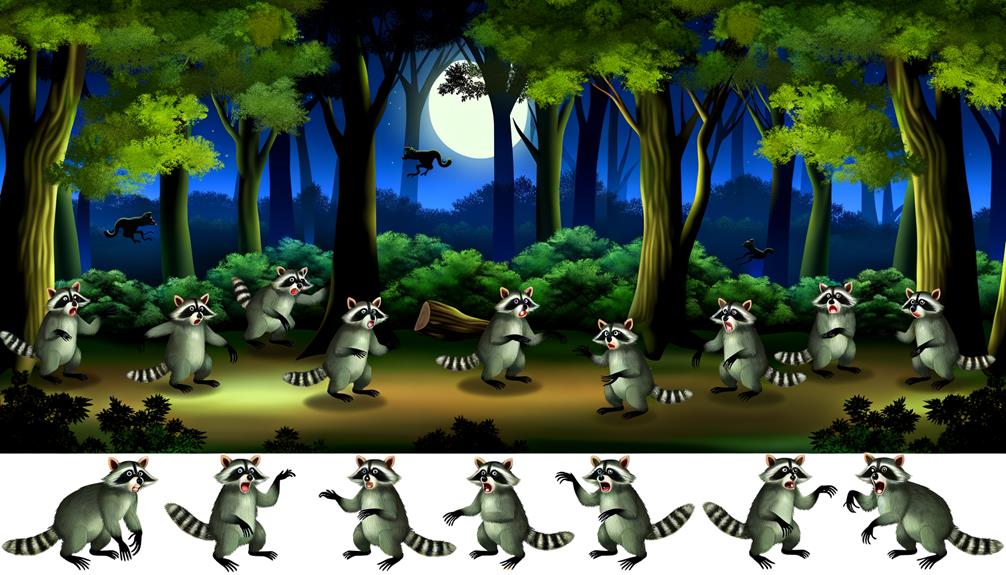
Understanding the complex social structures of raccoon groups requires examining their sophisticated communication methods. Raccoons utilize a variety of vocalizations, body language, and scent marking to convey information and maintain cohesion within their groups. Vocalizations range from purrs and growls to screams, each serving distinct purposes such as alerting others to danger or coordinating group activities. Body language, including tail positioning and facial expressions, plays a pivotal role in expressing emotions and intentions. Additionally, scent marking through urination or glandular secretions helps establish territory and identify individuals. The table below summarizes these communication methods:
| Communication Method | Description |
|---|---|
| Vocalizations | Purrs, growls, screams |
| Body Language | Tail positioning, facial expressions |
| Scent Marking | Urination, glandular secretions |
These methods are essential to the social dynamics of raccoon groups.
Urban Vs. Wild Settings
The social structures and behaviors of raccoons exhibit significant variability when comparing urban environments to wild settings.
In urban areas, raccoons often form larger, more cohesive groups due to abundant food sources and reduced predation risks, whereas wild raccoons tend to display more solitary or loosely connected social dynamics.
These distinctions highlight the adaptability of raccoon social behaviors in response to differing environmental pressures.
Urban Grouping Behaviors
In urban environments, raccoons exhibit distinct grouping behaviors compared to their counterparts in wild settings, influenced by factors such as resource availability and human activity. Urban raccoons tend to form larger, more cohesive social groups, driven by the abundance of food sources, such as garbage and pet food, and the reduced risk of predation. These environments also offer numerous shelter options, including attics and basements, which support group living.
Key observations include:
- Increased social interactions: Urban raccoons often display more frequent and complex social behaviors.
- Resource-driven congregation: Higher food availability leads to larger group sizes.
- Adaptability to human presence: Urban raccoons show a greater tolerance for human activity, facilitating group cohesion.
Understanding these behaviors is essential for effective wildlife management in urban settings.
Wild Raccoon Dynamics
While urban raccoons exhibit distinct social behaviors influenced by human activity and resource availability, their wild counterparts often display different dynamics shaped by natural environmental factors.
In natural habitats, raccoons are typically solitary, except during mating season or when mothers care for their young. Resource scarcity and predation pressures in the wild necessitate a more independent lifestyle, with raccoons covering larger territories to find food.
Conversely, urban environments provide abundant resources, facilitating higher population densities and increased social interactions. Studies indicate that wild raccoons rely heavily on their keen senses and adaptability to navigate complex ecosystems, whereas urban raccoons exploit anthropogenic resources, resulting in altered social structures and behaviors distinct from their wild relatives.
Winter Dens

Raccoons display a preference for well-insulated winter shelters, often choosing hollow trees, abandoned burrows, or attics to guarantee protection from harsh weather conditions. These shelters are essential for their survival during colder months, offering both warmth and safety. Raccoons are known to sometimes share these shelters with other raccoons, especially mothers with their offspring, to conserve heat.
Key characteristics of raccoon winter shelters include:
- Insulation: Ensures minimal heat loss, maintaining body temperature.
- Accessibility: Provides easy entry and exit while remaining secure from predators.
- Proximity to food sources: Facilitates foraging during milder winter days.
These attributes optimize the raccoons' ability to endure the winter season with minimal exertion and maximum protection.
Human Interaction
Human interaction with raccoons often occurs when these adaptable creatures exploit urban environments for food and shelter, leading to both opportunities and challenges for coexistence. Raccoons are highly intelligent, utilizing human waste and structures for sustenance and den sites. This behavior can result in property damage, spread of diseases such as rabies, and conflicts with pets.
Conversely, raccoons also contribute to urban ecosystems by controlling insect and rodent populations. Effective management strategies, including secure trash containers and exclusion techniques, can mitigate negative impacts. Public education on raccoon behavior and humane deterrents further aids in reducing human-raccoon conflicts.
Understanding these dynamics is essential for fostering a balanced coexistence between raccoons and urban human populations.
Conclusion
To sum up, raccoons exhibit a complex social structure that varies notably between solitary and group living, influenced by environmental factors and seasonal behaviors.
Remarkably, family units often disband after the breeding season, yet urban settings can encourage more communal living due to resource availability.
A remarkable statistic reveals that raccoons in urban areas exhibit a 50% higher survival rate compared to their wild counterparts, highlighting the profound impact of human-modified environments on their social dynamics and survival strategies.



